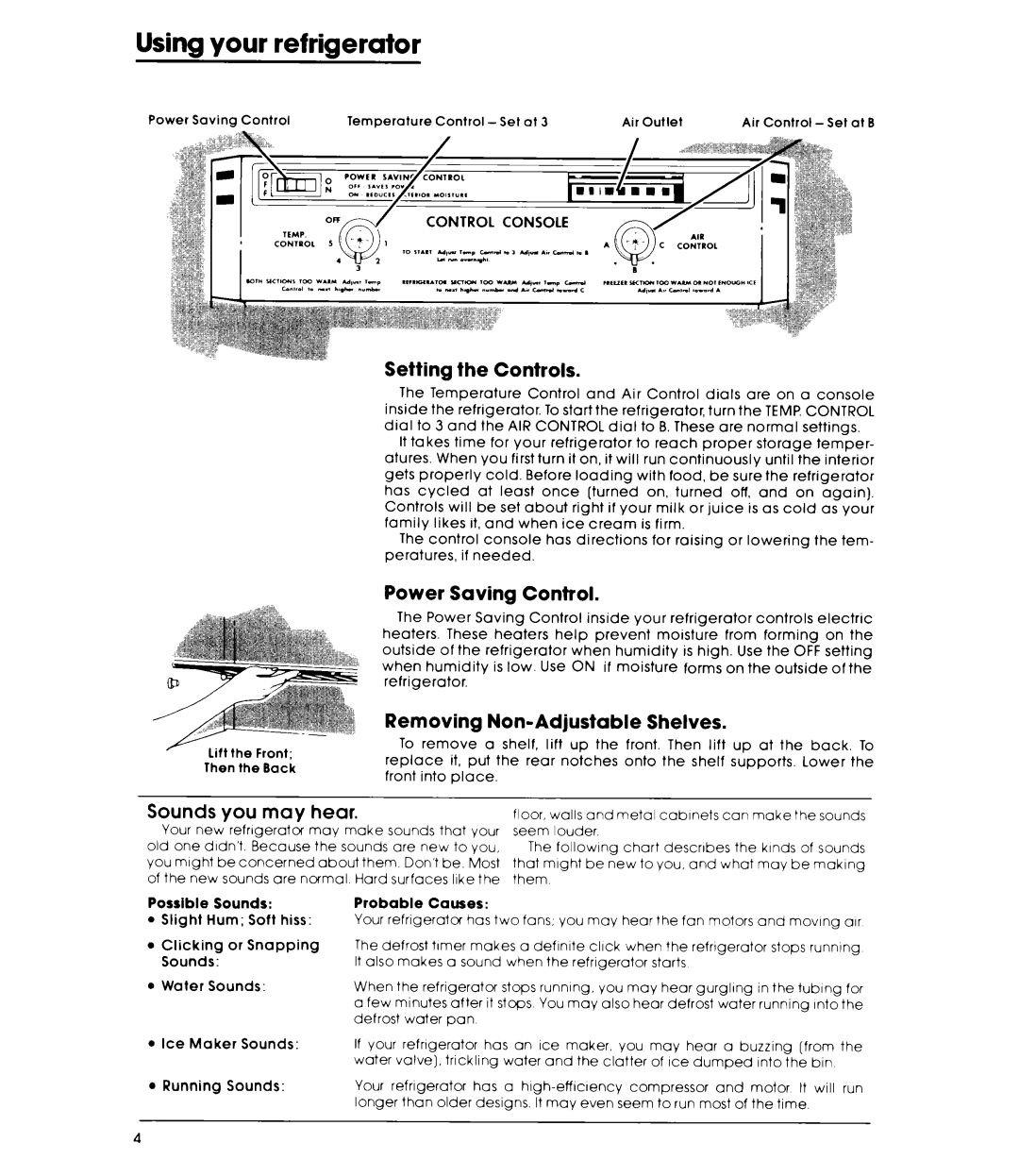
Using your refrigerator
Power Saving Control | Temperature | Control | Air Outlet | Air | at B |
Setting | the | Controls. |
|
|
|
|
|
|
|
|
|
|
|
|
|
| ||||||
The | Temperature |
| Control |
| and |
| Air | Control | dials |
| are | on | a | console | ||||||||
inside |
| the | refrigerator. |
| To start the | refrigerator, | turn | the | TEMP. CONTROL | |||||||||||||
dial | to | 3 and | the | AIR | CONTROL | dial | to | B. These are | normal | settings. | ||||||||||||
It takes | time | for | your | refrigerator |
|
| to | reach | proper | storage |
| temper- | ||||||||||
atures. | When | you | first | turn | it | on, | it will | run | continuously |
| until | the | interior | |||||||||
gets | properly | cold. | Before | loading |
| with | food, | be | sure | the | refrigerator | |||||||||||
has | cycled | at | least |
| once |
| [turned | on, | turned | off, | and | on | again). | |||||||||
Controls |
| will | be | set | about | right | if | your | milk or | juice | is | as cold | as | your | ||||||||
family |
| likes | It, and | when ice | cream |
| is | firm. |
|
|
|
|
|
|
| |||||||
The | control | console |
| has |
| directions |
| for | raising | or | lowering |
| the | tem- | ||||||||
peratures, | if | needed. |
|
|
|
|
|
|
|
|
|
|
|
|
|
|
|
| ||||
Power Saving Control.
The Power Saving Control inside your refrigerator controls electric
heaters. These heaters help prevent moisture from forming on the
outside of the refrigerator when humidity is high. Use the OFF setting
when humidity is low. Use ON if moisture forms on the outside of the refrigerator.
|
|
|
|
|
|
|
|
| :*- | Removing |
| Shelves. |
|
|
|
|
| |||||||||
|
|
|
|
|
|
|
|
| To | remove | a | shelf, | lift up | the | front. | Then | lift | up | at the | back. | To | |||||
|
|
|
|
|
|
|
|
|
| |||||||||||||||||
|
|
|
|
|
|
|
|
|
| replace | it, | put | the | rear | notches | onto | the | shelf | supports. | Lower | the | |||||
|
|
|
|
|
|
|
|
|
| front | into | place. |
|
|
|
|
|
|
|
|
|
|
|
|
| |
Sounds |
| you | may | hear. |
|
|
|
|
| floor, | walls | and | metal | cabrnets |
| can | make | the | sounds | |||||||
| Your | new | refrigerator | may | make | sounds that | your |
| seem | louder. |
|
|
|
|
|
|
|
|
| |||||||
old | one | didn’t. | Because | the | sounds | are | new | to | you, |
| The followrng | chart | descrrbes | the | krnds | of | sounds | |||||||||
you | might |
| be concerned | about them. Don’t | be. | Most |
| that might | be new to | you, | and |
| what | may | be | makrng | ||||||||||
of | the | new | sounds | are ncfmal | Hard | surfaces | lrke the |
| them |
|
|
|
|
|
|
|
|
|
|
| ||||||
Possible | Sounds: |
|
| Probable | Causes: |
|
|
|
|
|
|
|
|
|
|
|
|
| ||||||||
l | Slight | Hum; | Soft | hiss: |
| Your | refrigerator |
| has | two | fans, | you | may | hear | the | fan | motors | and | movrng | air | ||||||
l
l
Clicking | or Snapping | The defrost | trmer | makes a | defrnrte | click | when | the | refrrgerator | stops | running | ||
Sounds: |
| It also | makes | a | sound | when | the refrigerator |
| starts |
|
|
| |
Water | Sounds: | When | the refrigerator | stops | running. | you | may | hear | gurglrng | in the | tubrng for | ||
|
| a few minutes after it stops You may also hear defrost water running Into the | |||||||||||
|
| defrost | water | pan |
|
|
|
|
|
|
|
| |
l Ice Maker Sounds: If your refrigerator has an Ice maker, you may hear a buzzing (from the water valve], trickling water and the clatter of Ice dumped Into the bin
l Running Sounds:Your refrigerator has a
4
